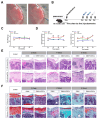Multiple Intra-Articular Injections of Adipose-Derived Mesenchymal Stem Cells for Canine Osteoarthritis Treatment
- PMID: 40072052
- PMCID: PMC11899304
- DOI: 10.3390/cells14050323
Multiple Intra-Articular Injections of Adipose-Derived Mesenchymal Stem Cells for Canine Osteoarthritis Treatment
Abstract
Osteoarthritis (OA) is one of the most common degenerative diseases in dogs and humans, which can lead to articular cartilage deterioration, chronic pain, and decreased quality of life. The anti-inflammatory, anti-fibrotic, analgesic, and cartilage regeneration properties of mesenchymal stem cell (MSC) therapy provide a new direction for the treatment development of OA in the future. Currently, MSC therapy lacks confirmed ideal sources, dosages, formulations, and specific characteristics. In this study, we evaluated the efficacy of multiple canine adipose-derived mesenchymal stem cell (ADSC) injections on anti-inflammation and joint cartilage damage in a canine OA model. Considering animal ethics, we simulated the effects of inflammation and cartilage repair during treatment through a mouse OA model. In the mouse OA model, through the detection of cartilage repair and inflammation-related key factors via histology and molecular biology, it was found that MSC therapy has a certain repair effect on cartilage, but the anti-inflammatory effect is time-dependent. In the canine OA model, we verified the feasibility of multiple injections of ADSCs. Compared with the control group, the cartilage repair effect of the treatment group was obvious, and the inflammatory factors decreased, showing an obvious therapeutic effect. This study demonstrates that multiple intra-articular injections of canine ADSCs could be effective in treating OA symptoms.
Keywords: MSC therapy; cartilage repair; mesenchymal stem cells; osteoarthritis.
Conflict of interest statement
The authors declare no conflicts of interest.
Figures





Similar articles
-
Intra-articular injection of human synovium-derived mesenchymal stem cells in beagles with surgery-induced osteoarthritis.Knee. 2021 Jan;28:159-168. doi: 10.1016/j.knee.2020.11.021. Epub 2020 Dec 29. Knee. 2021. PMID: 33385696
-
Intraarticular injection of processed lipoaspirate cells has anti-inflammatory and analgesic effects but does not improve degenerative changes in murine monoiodoacetate-induced osteoarthritis.BMC Musculoskelet Disord. 2019 Jul 19;20(1):335. doi: 10.1186/s12891-019-2710-1. BMC Musculoskelet Disord. 2019. PMID: 31324245 Free PMC article.
-
Culture-expanded allogenic adipose tissue-derived stem cells attenuate cartilage degeneration in an experimental rat osteoarthritis model.PLoS One. 2017 Apr 18;12(4):e0176107. doi: 10.1371/journal.pone.0176107. eCollection 2017. PLoS One. 2017. PMID: 28419155 Free PMC article.
-
Clinical Trials with Mesenchymal Stem Cell Therapies for Osteoarthritis: Challenges in the Regeneration of Articular Cartilage.Int J Mol Sci. 2023 Jun 9;24(12):9939. doi: 10.3390/ijms24129939. Int J Mol Sci. 2023. PMID: 37373096 Free PMC article. Review.
-
Mesenchymal stem cell-based treatment for cartilage defects in osteoarthritis.Mol Biol Rep. 2012 May;39(5):5683-9. doi: 10.1007/s11033-011-1376-z. Epub 2011 Dec 20. Mol Biol Rep. 2012. PMID: 22183306 Review.
References
-
- Anderson K.L., O’neill D.G., Brodbelt D.C., Church D.B., Meeson R.L., Sargan D., Summers J.F., Zulch H., Collins L.M. Prevalence, duration and risk factors for appendicular osteoarthritis in a UK dog population under primary veterinary care. Sci. Rep. 2018;8:5641. doi: 10.1038/s41598-018-23940-z. - DOI - PMC - PubMed
Publication types
MeSH terms
LinkOut - more resources
Full Text Sources
Medical

